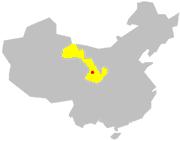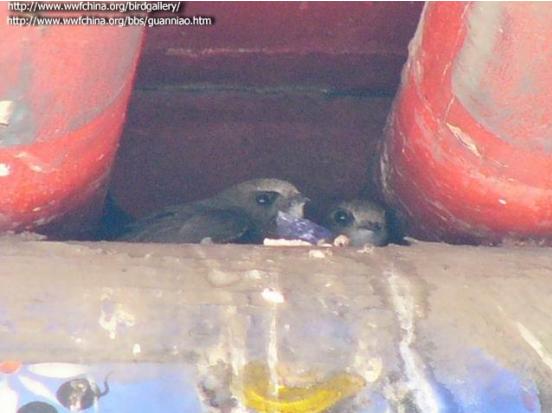Report on
Wang, Xiang-ting (1958): 兰州“北京雨燕”生态的初步研究 (A Preliminary study on the ecology of the Common Swift in Lanzhou) (Chinese). Shengwuxue tongbao (Sheng-wu-hsueh T'ung-pao / Bulletin of Biology) 07: 15-18, 57
(APUSlist No. 1367)
by ROBIN YUAN
Lanzhou is the capital of the Chinese Province of Gansu and lies in a narrow valley between loess mountains at an average altitude of 1517 m above sea level. The wind circulation is very low and the temperatures today are about 6-7° C warmer than the surrounding areas during the night (1).
The geographical position of Lanzhou in the People’s Republic of China
Lanzhou and Gansu Province in China.

Lanzhou and Gansu Province in China. Source: Wikipedia
The local name of Apus apus pekinensis in Lanzhou is "Motley Swallow".
The body measurements of the Common Swift or Motley Swallow are: length:171-180mm, wing:169-172mm, tail:74-76mm, tarsus:10-10.4mm, weight:34-36.5g.
The Common Swift arrives in Lanzhou and the surrounding areas from the end of April to the beginning of May. It nests on a variety of structures. Fifty-five nest sites were examined; they were found at a variety of altitudes:
|
Sites |
Number |
Height (m) |
|
city gate tower |
34 |
8-20 |
|
eaves |
15 |
3.5-8 |
|
wall gap |
4 |
4-6.5 |
|
rock aperture |
2 |
6-9 |
Table1. The nest height of Apus apus
The nests are mostly built on three different types of site:
|
Nest type |
Position |
|
Half deep bow |
side of the rafter |
|
Loop |
above the purlin |
|
Shallow bow |
gap/aperture |
Table 2. Nest types and their position

A nest above a purlin Photo wwfchina.org
The nests were built of different material, the outer part of leaf, stem, root, plant material, while the inner part contained fibres, cotton, feathers, thread, wastepaper, and animal hair such as sheeps' wool or the hair of the Siberian Musk deer, Moschus moschiferus. The sizes were 80-105 mm in diameter and 10-25mm high.
It was found that only one adult bird can sit in the nest at a time.
The Common Swifts mate from June 5 to June 9 and lay eggs from June 12 to June 20. The clutch size is 2-3 eggs. The size of the egg is 24-25 x 16-17mm. The incubation period is about 21-23 days.
It was found that the diets of the parent birds and of the chicks were quite different. Five samples from different months were taken.
|
Date |
Coleoptera |
Hemiptera |
Homoptera |
||||
|
|
Curculionidae |
Chrysomelidae |
Elateridae |
Staphylinidae |
Pentatomidae |
Aphididae |
unknown |
|
4 Apr. |
1 |
2 |
- |
- |
34 |
- |
88 |
|
6 May |
- |
3 |
1 |
4 |
85 |
7 |
121 |
|
6 June |
- |
- |
- |
- |
102 |
24 |
131 |
|
2 July |
- |
- |
- |
- |
28 |
22 |
42 |
|
6 Aug. |
- |
- |
- |
2 |
93 |
36 |
123 |
|
Date |
Diptera |
Hymenoptera |
Odonata |
Arachnida |
|||
|
|
Culicidae |
Muscidae |
Tabanidae |
Formicidae |
Apoidea |
Libellulidae |
|
|
4 Apr. |
- |
32 |
3 |
6 |
2 |
- |
3 |
|
6 May |
4 |
54 |
8 |
4 |
7 |
- |
- |
|
6 June |
2 |
44 |
4 |
2 |
- |
1 |
- |
|
2 July |
4 |
17 |
3 |
1 |
- |
4 |
2 |
|
6 Aug. |
- |
34 |
17 |
- |
1 |
- |
- |
Table 3a + b. Food components of the diet of adult birds
|
Date |
Coleoptera |
Hemiptera |
Homoptera |
||||
|
|
Curculionidae |
Chrysomelidae |
Elateridae |
Staphylinidae |
Pentatomidae |
Aphididae |
unknown |
|
10 July |
- |
2 |
- |
- |
221 |
45 |
431 |
|
20 July |
- |
7 |
- |
9 |
570 |
63 |
1338 |
|
29 July |
- |
1 |
- |
4 |
839 |
104 |
2034 |
|
8 Aug. |
- |
- |
- |
13 |
2383 |
217 |
3352 |
|
Aug. |
- |
- |
- |
2 |
93 |
36 |
123 |
|
Date |
Diptera |
|
|
Hymenoptera |
Odonata |
Arachnida |
|
|
|
Culicidae |
Muscidae |
Tabanidae |
Formicidae |
Apoidea |
Libellulidae |
|
|
10 July |
26 |
119 |
32 |
- |
6 |
- |
- |
|
20 July |
17 |
249 |
74 |
67 |
8 |
24 |
- |
|
29 July |
32 |
464 |
65 |
49 |
4 |
75 |
4 |
|
8 Aug. |
46 |
674 |
106 |
86 |
16 |
54 |
- |
|
Aug. |
- |
34 |
17 |
- |
1 |
- |
- |
Table 4 a + b. Food components of the diet of two young birds
Arrival and the departure dates of the Common Swift recorded during 1954 -1956 were similar.
|
Immigration |
Emigration |
Duration of stay |
|
3 May 1954 |
29 Aug. 1954 |
118 days |
|
30 Apr. 1955 |
30 Aug. 1955 |
122 days |
|
27 Apr. 1956 |
30 Aug. 1956 |
125* |
Table 5. Arrival and departure * 135 days in the original article (a mistake)
Some interaction with other species was recorded. Wang observed a domestic cat attack the young birds twice and a Sparrow was seen flying into the Swift’s nest to collect the residue of insects to feed its own juveniles. The nests of these two species were only 18 inches away from each other. When the Common Swift was feeding, the Sparrow flew near to the Swift nest and made noise so that some food dropped from the Swift's beak. Other threats came from parasites. The larva of one species of Coleoptera lives mainly on the body or shed skin and feathers. Wang checked three dead bodies of juvenile Swifts and found that there were holes gnawed by these insects in the birds' bellies.
In 1956 the flight activities in one nest were recorded. Feeding the chicks is the period when flight activity is greatest.
Daily activity times of Common Swifts in Lanzhou
|
1956 Date |
Nest number |
Out time |
In time |
Duration of flight activity |
|||
|
The earliest time |
The latest time |
The earliest time |
The latest time |
least |
most |
||
|
10 May |
4 |
6:00 |
6:15 |
8:10 |
8:23 |
13:47 |
14:23 |
|
30 May |
4 |
5:40 |
6:00 |
8:00 |
8:30 |
14:00 |
14:50 |
|
12 June |
4 |
5:30 |
6:00 |
8:30 |
9:05 |
14:30 |
15:55 |
|
2 July |
4 |
5:28 |
5:40 |
8:47 |
9:08 |
15:07 |
15:45 |
|
3 July |
4 |
5:27 |
5:52 |
8:36 |
9:10 |
14:44 |
15:53 |
|
5 August |
4 |
5:45 |
6:05 |
7:50 |
8:05 |
13:45 |
14:50 |
|
25 August |
4 |
5:50 |
6:10 |
7:40 |
8:00 |
13:30 |
14:05 |
Table 6. Daily flight activity at the nest site
© APUSlife 2008, No. 3672
ISSN 1438-2261
Email address of the reporter: yzuoping@yahoo.com.cn
(1) Savijärvi, Hannu & Jin, Liya (2004): Local Winds In A Valley City. Boundary-Layer Meteorology 113: 301-319 or http://www.springerlink.com/content/k42v0n76p0542603/